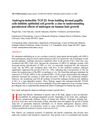TLDR Brain-Derived Neurotrophic Factor (BDNF) slows down hair growth and promotes hair follicle regression.
The document from April 1, 2005, presents a study on the effects of Brain-Derived Neurotrophic Factor (BDNF) on human hair growth. The study found that BDNF, at a concentration of 50 ng/mL, significantly inhibited hair shaft elongation, induced premature catagen development, and inhibited keratinocyte proliferation in organ-cultured human anagen hair follicles. BDNF also upregulated the expression of Transforming Growth Factor β2 (TGFB2), a known inducer of catagen. The induction of catagen by BDNF was partially reversible with the co-administration of TGFB-neutralizing antibody, indicating that BDNF/TrkB signaling may promote the transition from anagen to catagen partly through TGFB2 upregulation. These findings suggest that BDNF/TrkB signaling could be a potential target for therapeutic hair growth modulation. The number of hair follicles used in the study was not specified.
 190 citations
,
October 2002 in “The FASEB journal”
190 citations
,
October 2002 in “The FASEB journal” Androgens may cause hair loss by increasing TGF-beta1 from scalp cells, which inhibits hair cell growth.
112 citations
,
February 2001 in “Journal of Investigative Dermatology” Neuropeptides affect hair growth, with some speeding it up and others slowing it down.
 96 citations
,
October 2000 in “The FASEB Journal”
96 citations
,
October 2000 in “The FASEB Journal” The p75 neurotrophin receptor is important for hair follicle regression by controlling cell death.
14 citations
,
September 1999 in “Journal of Investigative Dermatology” Lack of TrkC receptor delays hair follicle development.
 1113 citations
,
August 1999 in “The New England Journal of Medicine”
1113 citations
,
August 1999 in “The New England Journal of Medicine” Hair follicle biology advancements may lead to better hair growth disorder treatments.
 22 citations
,
August 1999 in “Experimental Dermatology”
22 citations
,
August 1999 in “Experimental Dermatology” Certain drugs can cause early hair growth in mice by affecting the nerves.
140 citations
,
December 1998 in “Journal of Investigative Dermatology” Apoptosis in hair follicles varies by growth phase, with TGF-β possibly starting the catagen phase.
130 citations
,
December 1998 in “The journal of investigative dermatology/Journal of investigative dermatology” Hair follicle melanocytes die during hair regression.
133 citations
,
July 1994 in “Journal of Dermatological Science” Human hair growth can be influenced by certain growth factors and has specific metabolic needs.
 August 2014 in “Journal of clinical & experimental dermatology research”
August 2014 in “Journal of clinical & experimental dermatology research” Platelet-released growth factors can treat hair loss by activating hair follicle stem cells, blocking certain pathways, and controlling inflammation and fibrosis.






